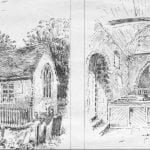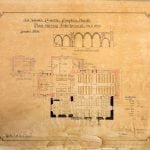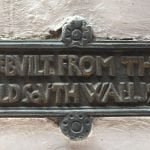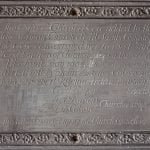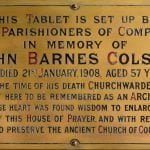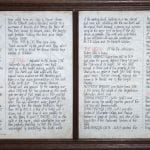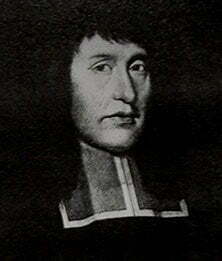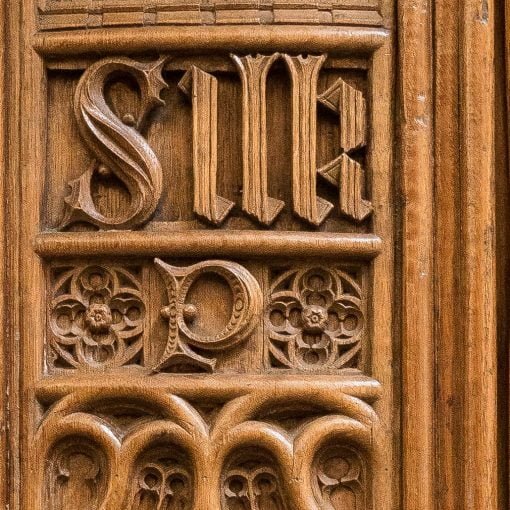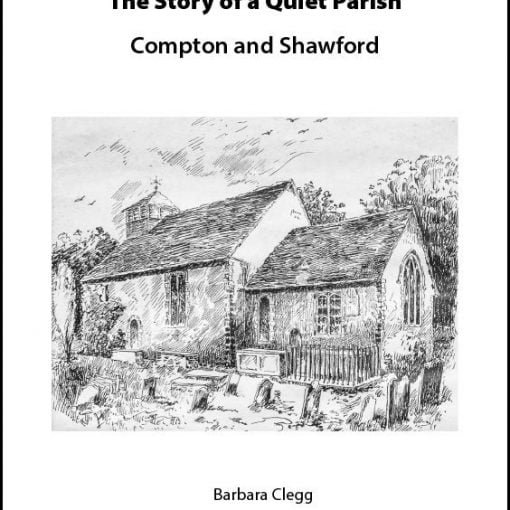Table of Contents
All Saints Compton Extension 1905
This photo gallery shows line drawings and a painting of the church before its 1905 extension, and architects’ drawings before and after. Also two plaques, and a framed Parish History.
Click on any image to see a larger version.
- Pen drawing of All Saints Compton exterior and interior before the 1905 extension
- Watercolour of the entrance to All Saints’ Church, Compton before its 1905 extension, showing the different position of the font. Written on the back: “Irene Whatmore, Larchwood, Compton”
- Architects’ drawings of Compton Church before the 1905 extension
- Architects’ drawings of Compton Church after the 1905 extension. Reproduced by permission of the Hampshire Records Office. Item reference 1M76/PW16 The drawing identifies windows which were moved from the old church and shows their new location.
- Typical brass plaque marking a window or other item relocated from the old church.
- Pewter plaque commemorating the consecration of the 1905 extension to All Saints Compton.
- Brass memorial in Compton Church to John Barnes Colson, Architect and Churchwarden.
- Barbara Clegg’s summary of significant events in the history of the parish as recorded in a 1963 framed display in All Saints’ Church. Italic script by Miss Gillian Lowe.
Inscription on pewter plaque
This Nave & Chancel were added to the old Norman Church of All Saints Compton and were consecrated by Herbert Ryle Lord Bishop of Winchester on the eve of All Saints day 1905, the designs being carried out by John Barnes Colson and George Herbert Kitchin, Architects and Parishioners.
Cecil Cooper Rector
J.A.Pearson, J.B.Colson ChurchwardensThis tablet was set up by the Church Council 1929
About the Extension project
Whitaker writes, of the beginning of the 20th century
The church was still the unifying influence in the life of the village. It had changed little in outward appearance since it was built about 1150, but its single nave was no longer big enough for the growing population once Shawford had begun to expand. One suggestion was to build a new church on the western end of the Down, near Shepherds Lane; fortunately this was abandoned in favour of the present plan, the addition of a second nave to produce the harmonious building we have today. The enterprise owed most to the energy of the rector, the Revd. Cecil Cooper, and the imagination of two Compton architects, Mr. J. B. Colson and Mr. Herbert Kitchin, who gave their services free. The conversion was completed in the astonishingly short time of May to November 1905 and was paid for by the parishioners.
Drew writes
The rectorate of Cecil Henry Hamilton Cooper, which began in this 1904, will always be memorable in Compton because it was under his guidance that the extension of the church was taken in hand and brought to completion.
The Norman church had provided accommodation for only 70 people, and it was of course quite inadequate for the needs of the growing parish. A scheme had been proposed to erect an entirely new church, on land promised as a gift by a parishioner, near the junction of the main-road and Shepherds Lane.
It was now decided, however, that, instead of this the old church should be extended to meet the new needs : and few will doubt that the decision was a wise one. The work – the most important undertaken in the parish for 750 years – began in May 1905 and was finished in time for the Consecration to take place on the vigil of All Saints the same year.
The architects were two parishioners, Mr. J. B. Colson and Mr. Herbert Kitchin and they generously refused to accept payment for their services ; Mr. Caröe acted as consulting architect, and the contractor was Mr. Ansell of Southampton.
It was a happy combination, and how well they succeeded can be seen by all. The Norman church had been justly described by the Bishop of Winchester as one of the gems of his diocese, and, in less competent hands, the result of adding a second chancel and nave might have been disastrous. As it is, old and new have been blended in the happiest way, not one ancient stone was moved without imperative necessity, and the new work with its restrained dignity, does not detract from – it even enhances – the beauty of the old. Where removal of ancient work was unavoidable, as in the case of the south doorway, a nave piscina and certain windows in the old south wall, these were re-erected with great care in their corresponding positions in the new part of the church and were duly labelled for the benefit of those who come after.
All this, however, could not be done without money, and it was here that the parish had its chance. The contract price of the building was £3000 and by the united efforts of all, rich and poor, men, women and children, this largesum was raised. And it did not stop there; the generosity of individuals provided the east window, the Altar and its ornaments, the Choir Stalls and all those other things which help to beautify the chancel. Compton Church, as we see it today, is a monument, as much to the devotion of its people as it is to the skill of those who designed and built it.
Two years later a new organ was installed, Mr. Andrew Carnegie, the Scottish-American philanthropist, giving £125 towards the cost. In 1910 the marble pavement around the font was given by George Henry Mildmay Ricketts, C.B., a descendant of the Roger Harris whose connection with Silkstead, 200 years before, has already been recorded.
Parish History
Below the George Fawkes memorial west window in the “new church” there is a framed brief history of the church and the parish.
The text was written by local historian and playwright Barbara Clegg.
July 1963 Parish Magazine Rector’s Letter
Mrs. Clegg’s summary of the history of Compton and its church has now been reproduced in clear script by Miss Gillian Lowe, and it has replaced the old and inaccurate version (in places referring to a different Compton) under the west window. I would like to thank them both for their giving of so much time and care to this work, which has already been closely studied by a number of visitors.
E.G.D.F.
E.D.G.F is George Fawkes, Rector from 1958 to 1973
THE PARISH OF COMPTON includes the two hamlets of Shawford and Silkstede. These names are Anglo-Saxon in origin.
- Compton = “Combe – tun” – “the village in the valley”
- Shawford = the “Schald” or shallow ford
- Silkstede = the “steding” or farm buildings of one Selc.
Compton is known to have been included a gift of land “for seven leagues around the city” (of Winchester) to the church for evermore made by Cynewalc, King of the West Saxons in 643.
Compton was part of the Manor of Chilcombe and its “Lord” was the Prior and monks of the Benedictine Priory of St. Swithun’s, Winchester, and after the Reformation, their successor the Dean and Chapter of the Cathedral.
THE HISTORY OF THE PARISH has been that of a farming community, with various families coming to the fore from time to time – the Wascelyns from about 1278 to 1360, the Philpotts from about 1450 to 1660, and the Goldfinches from 1596 to 1870. These three families in successive generations gradually built up a large farm in the north of the parish. From 1870 to 1902 the “Compton Farm” was in the hands of the Lynes, father and son, and then farmed by Wilfrid Godwin until his retirement in 1953 when it was bought by the County Council and divided into smallholdings.
At Silkstede the Priors built a large walled farm, and later a Manor House.
From the fifteenth century, this land was let to a succession of tenants and forms the farm of New Barn, owned by Edward Judd, the twenty-sixth freeholder holding this land since Ralph Wascelyn (1248)
From 1593 to 1715 there were many “Papist recusants” in the parish and from about 1680 to 1690 a school for Roman Catholic boys existed at Silkstede.
THE CHURCH dedicated to All Saints (“All Hallownde” in old documents) was built sometime in the twelfth century, probably about 1155.
The North and West walls with their original narrow windows are still standing, and there is a fine zigzag ornamentation on the arch of the North door.
The original Norman Chancel arch was replaced by the existing one about 1300 and the two windows on the north side are also of that period, as is the painted figure on the splay of the window next to the altar.
This was discovered under layers of plaster by the Rev. Charles Wickham, Rector from 1871 to 1902. It is that of a bishop with a crozier, and at one time it was possible to see the letters S (anc) T THEOPH__US on the right of the figure, which nevertheless has not been identified.
In 1905 the Church was enlarged by demolishing the South walls of the existing church, building on a new chancel and nave, and rebuilding into the new South wall the original South doorway, a piscina and window, using at the same time as many of the old stones as possible. The work was undertaken by two architects who were also parishioners, Mr. J. B. Colson and Mr. Herbert Kitchin.
THE RECTORS: Of the Pre-reformation Rectors little is known.
DAVID SIBBALD Rector from 1517 to 1534 died when the quarrel between Henry VIII and the Pope was at its height but was bold enough to leave most of his property to the Observants, an order of friars who held strong papal views. Thomas Cromwell ordered the monies to be handed over to the King’s Majesty.
ANTHONY BARKER was rector from 1536 to 1551 during the whole of the tempestuous Reformation period, and
THOMAS HACKETT (1636-1661) was Rector during the equally troubled years of the Civil War and Commonwealth.
JOHN HARMER (1595-1613) was also Warden of Winchester College and Regius Professor of Greek at Oxford, and one of the translators of the Authorised Version of the Bible.
JOHN BARTON (1678-1683) started the Parish Register of Burials. He recorded a parish collection of £1-18s-1d for the rebuilding of St. Paul’s, destroyed by the Great Fire of London. His successor
JOHN WEBBE (1683-1721) started the Register of Baptisms.
CHARLES SCOTT (1724-1736) built a new rectory, the fine house at the West side of the Church. It was used as the rectory until 1937 when the modern rectory was built in part of the garden.
He also built a gallery at the west end of the church, which was removed by the Rev Charles Wickham, Rector in 1879.
PHILIP WILLIAMS (1781-1830) was the last of the many pluralist rectors, He was much beloved, and a memorial to him hangs on the north wall of the old church; his memorial to his wife is on the north-west wall of the new church.
The School The original Church of England Voluntary School for the “Education of the Labouring Classes” was built in 1838, on land leased to the Church by Sir William Heathcote. It was supported by voluntary contributions and the scholars’ pence. Attendance was voluntary until the Education Act of 1870, when the school was enlarged (1872). Further additions were made in 1900 and in 1958. It is now a Church of England School for Juniors.
References
- Compton near Winchester – being an Enquiry into the History of a Hampshire Parish; J S Drew, published 1939 by Warren and Sons, Winchester
- Compton & Shawford, by Austin Whitaker, ©1985, Published by Barbara Large & Austin Whitaker
- See also All Saints Compton Stained Glass Windows for information about the new east window by Charles Eamer Kempe, donated by churchwarden J.A.Pearson.
- Looking back to The 1905 Extension to Compton Church – Rev Cecil Cooper writes in the 1938 Parish Magazine, and talk given at the extension’s 75th anniversary in 1980.

